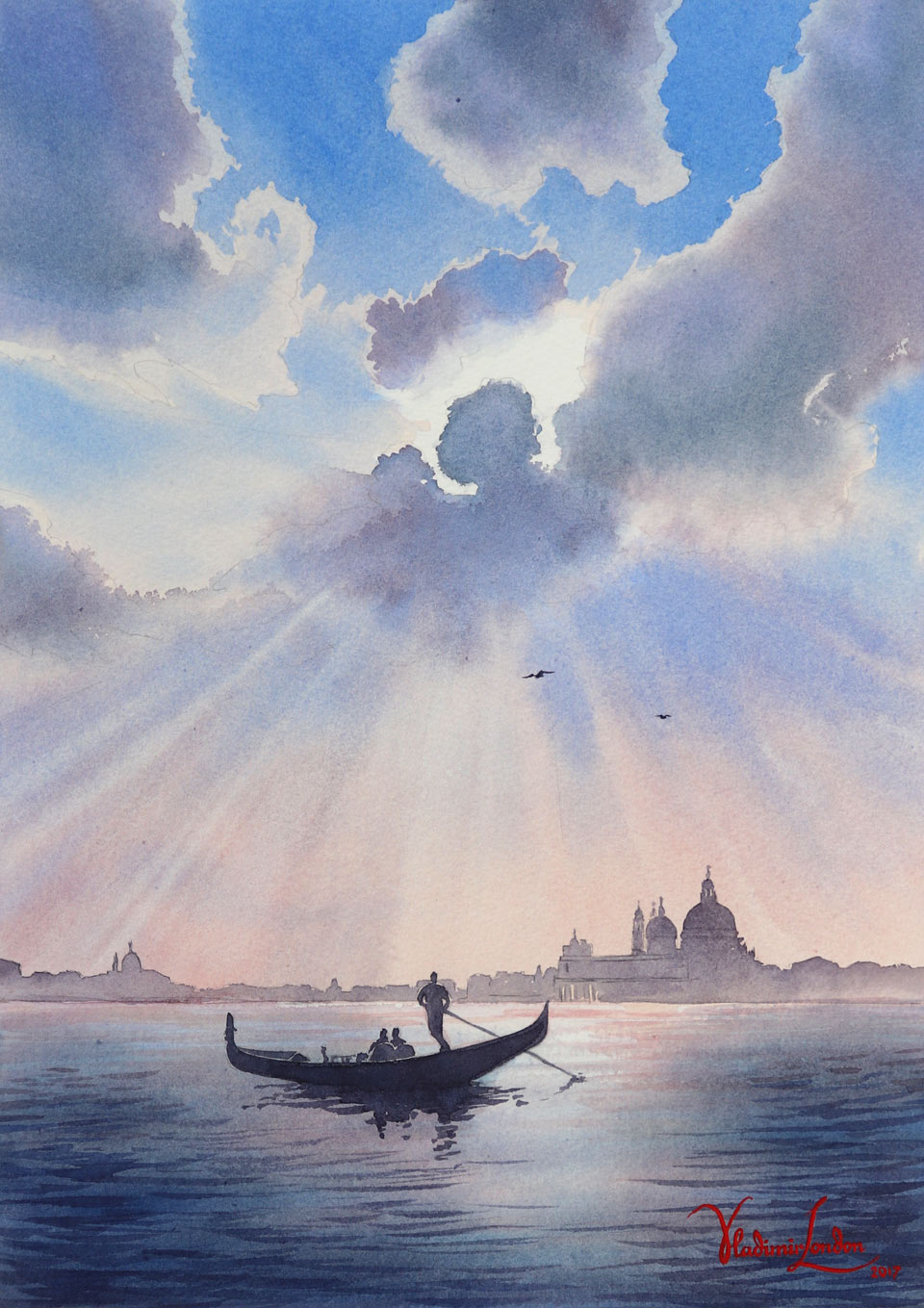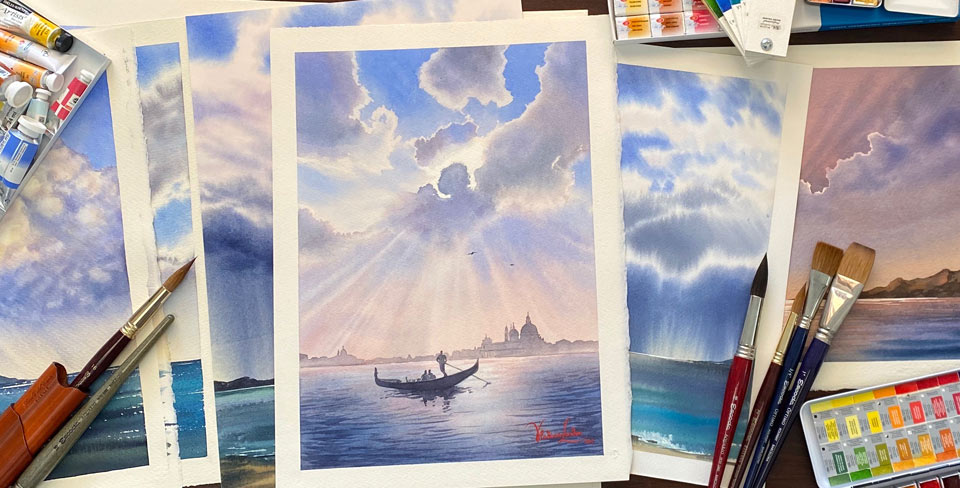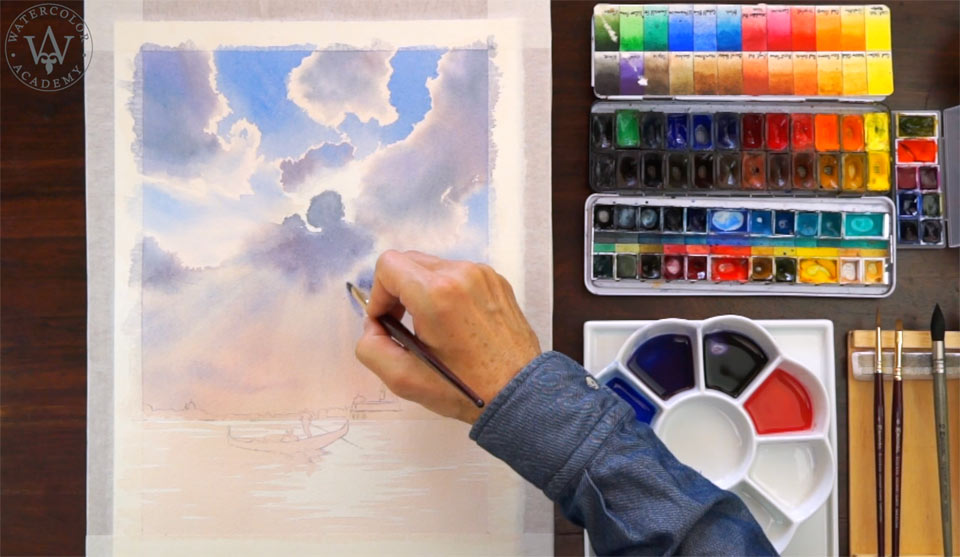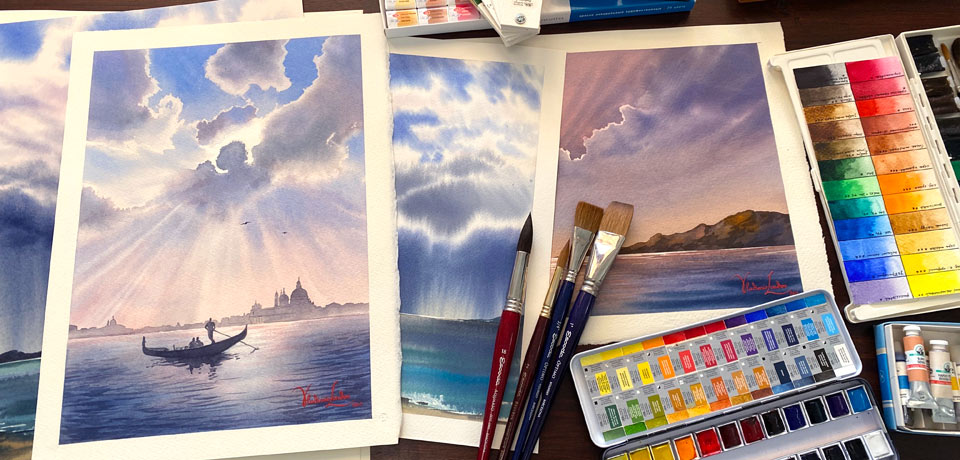A self-study, self-paced course where you can learn how to paint in watercolor by watching video lessons and doing assignments
$297 USD
ENROLL NOWA self-study, self-paced course where you can learn how to paint in watercolor by watching video lessons and doing assignments
$297 USD
ENROLL NOWOne-to-one, unlimited and custom-tailored to your skills and needs Personal Tutoring by the Watercolor Academy teachers
$997 USD
ENROLL NOWVideo lesson by Vladimir London
In this video lesson, you will discover how to paint sky and water using the 'wiping-off' and 'washing-out' techniques.
Here is the artwork that I will achieve by the end of this lesson.

The inspiration for this artwork is the beautiful skyline of Venice. It is just before sunset, there are some clouds in the sky, and the colors of the scenery are both cold and warm. Of course, the main focus will be not on the architecture but on the sky and water. I start by premixing a warm color for the imprimitura. I am using Cadmium yellow and a Carmine paint made of red pigment PR170. This mix of yellow and red gives us a nice-looking orange color, which I will use to cover almost the entire sheet of watercolor paper. I apply this mix with a soft mop brush from Escoda. It is a great brush for such a wash. I add a little bit of the Madder Red Lake paint, to make the color of the sky, which is closer to the horizon, slightly warmer. I have left a white unpainted area in the middle of the artwork; this will be the place for the Sun.

I continue using the same orange mix to paint the sea water. I do this with horizontal brushstrokes, leaving white gaps of unpainted paper between them. Such brushstrokes are shorter and thinner closer to the horizon, and bolder and longer on the foreground. I premixed the Payne's Gray and Indigo paints from Windsor & Newton to obtain a dark blue color. I also need a mix of pure blue Ultramarine, as well as three more colors mixed from various blue and red pigments.
In order to obtain your desired colors, the choice of paints you use for this purpose is entirely your choice. The topic of how to mix pigments and achieve different colors is fully covered in the dedicated video lessons on color theory of the Watercolor Academy course. After testing the mixed colors, I can begin painting the sky, using all five mixes. The different colors will be applied on paper next to each other, overlapping the borders of painted areas, so that the neighboring colors intermix with each other. You are already familiar with this painting technique – it is the variegated wash.
I am using muted and desaturated blue and red colors to paint the clouds; and I depict the clear sky between the clouds using blue Ultramarine. Between the areas of pure and muted colors, I leave an unpainted white edge; this is the clouds' outline. This combination of a dark cloud color with white edges happens when we look at clouds against the light. This is when sunrays highlight thin edges, and do not penetrate through thick clouds. Of course, the white borders are not pure white, because I have applied very light orange imprimitura in the first layer. As I come closer to the horizon, the tonal values of the sky become lighter.

To make softer gradations of colors, and more diffused borders, I slightly wet the paper surface with clean water using a flat natural-hair paintbrush. For painting the sky and clouds, I am using a smaller, flat brush – this holds less water than the same width, round brush. For the purpose of my creative task, I do not want to overload the paper with water, so a small flat brush is an ideal tool for this job. I am now coming closer to the horizon, and I will add more clear water onto the paper surface, which allows me to continue painting wet-into-wet. The reason why I am changing the painting technique from wet-on-moist to wet-into-wet is because I want to achieve softer borders of clouds, and more diffused areas of colors, to create an illusion of aerial perspective. According to the rules of this perspective, objects that are located further from a viewer appear less defined and are lighter in tone. The color of the sky that is closer to the horizon is warmer. I am using the red colored mix to paint it. I apply diagonal brush strokes that radiate from the Sun.

We now approach the subject of this video lesson, which is: 'how to paint the sky using the wiping-off technique'. I dry the brush with a paper towel and wipe the paint off of the paper surface in diagonal brushstrokes. I also apply clean water along those strokes, to dilute the paint and wash out more pigment from the surface. This means that both 'wiping-off' and 'washing-out' are used here to create an illusion of sunrays. I am also using a damp paper towel to absorb diluted paint. You will find that a damp paper towel does the job better than a dry one. I now add more paint to depict the shadows between sunrays. While this paint is wet, I can easily wipe it off to highlight the rays which are radiating from the sun. I do this with a flat brush which is damp and absorbs thin lines of pigment.
When wiping off, you may need to repeat the process several times, because wet paint may flow back into clear areas. There is one good rule here: not to overdo the wiping-off and washing-out process, otherwise the result may look artificial or dull. With the sunrays in place, I can now see that the top of the sky is too bright. I will give it a slightly darker tone by applying a coat of blue Ultramarine paint. For this purpose, I will use a gradated wash that starts darker at the top and gradually changes its tonal values, becoming lighter and lighter. To make such a gradation, I am adding more clean water onto the paper surface to dilute the blue mix so that it will gradually disappear at the bottom.
The sky is now darker at the top, but I would like to highlight the edges of the clouds, and to do it, I am using the wiping-off technique once again. I rinse the paintbrush in clean water and dry it with a paper towel, to use this brush for wiping the paint off of the paper. When drying the brush, it is very important not to pull its hairs but to instead gently squeeze them between your fingers. I will dry the artwork before continuing with the painting process. The skyline of the city of Venice is painted as a silhouette, without many details. To paint the stretch of water wet-into-wet, I will first moisten this area with a flat white brush, and then apply premixed colors with a small flat brush. Such a brush holds little water, which is practical to achieve the right balance between paper wetness and the amount of water on the brush.
Coming back to the topic of this video lesson, of how to apply the wiping-off and washing-out technique when painting sky and water, I have to say that these techniques are quite special, and you won't be using them in every artwork. Removing pigments either from wet or dry paper is only needed to highlight any special places of the artwork, but it should not be your primary technique for preserving white. If you would like to develop great and experienced watercolor painting skills, you have to learn other ways of keeping white watercolor paper unspoiled.
Here is one good rule: if you are using wiping-off and washing-out too often, it may indicate that you are not using other painting techniques to their full potential. This especially applies to washing out paint which is already dry. If this is the technique that you rely on, in order to control tonal values, this could only mean that you didn't do the right job for preserving white in the first place. Nevertheless, I know at least one professional watercolor artist who turned the wiping-off and washing-out techniques into his personal creative style. If this is your objective, then you are welcome, by all means, to practice the wiping-off and washing-out method to the point of perfection. Otherwise, you can do it sporadically, by only in cases were this technique is required, for example, as demonstrated in this artwork when depicting the sunrays on the sky...
A self-study, self-paced course where you can learn how to paint in watercolor by watching video lessons and doing assignments
One-time payment - Lifetime membership
$297 USD
One-to-one, unlimited and custom-tailored to your skills and needs Personal Tutoring by the Watercolor Academy teachers
One-time payment - Lifetime membership
$997 USD